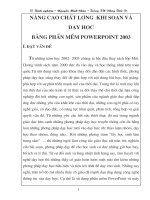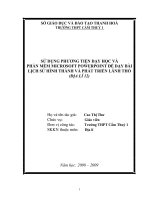waiver day powerpoint
Bạn đang xem bản rút gọn của tài liệu. Xem và tải ngay bản đầy đủ của tài liệu tại đây (234.4 KB, 17 trang )
Guided Math
Presented by Christina Goldner and Carla Wilson
Principles of Guided Math
•
•
•
•
•
•
All children can learn mathematics
A numeracy-rich environment promotes mathematical learning by students
Learning at its best is a social process
Learning mathematics is a constructive process
An organized classroom environment supports the learning process
Modeling and think-alouds combined with ample opportunities for guided and independent
problem solving and purposeful conversations, create a learning environment in which students’
mathematical understanding grows.
•
Ultimately, children are responsible for their learning
» Laney Sammons, Guided Math: A Framework for Mathematics Instruction
Creating a Classroom Environment of Numeracy
“Environments rich in mathematical opportunities
for children are essential if we want our children to
develop a thorough understanding of mathematics.”
How do we create a math-rich classroom environment?
•
•
•
•
•
•
•
•
•
•
Turn and talk about math concepts
Investigate
Word wall - />Calendar
Math partners
Math journals
Elbow partners
Problems of the day
Personal calendars or agendas
Numeracy related classroom jobs
Components of Guided Math
•
Math warm-up – problem of the day, number of the day math stretch, math current events (10-15
minutes)
•
•
Pretesting – using data to drive instruction
Whole group instruction
–
–
•
•
Workshop days – 10-15 minute mini-lesson
Small group instruction/Conferencing
Workshop
–
–
•
Non-workshop days could be entire block
Independent practice (anchor papers)
Center activities or “choices”
Assessment for learning
Sample Schedule for
Workshop Day
•
8:50-9:10
Warm-up or morning stretch
»
•
9:15-9:30
Guided Practice – Mini-lesson
»
»
»
•
Whole group setting
Teach a mini-lesson on a particular concept
Students participate
9:30-10:15 Guided Math Groups
»
»
»
•
(on desk or board when students arrive)
10:15-10:20
Could be 3-15 min. groups or 2-20 min. groups or 1 group
Guided Math Instruction – with small groups on known or unknown content
Other students participate in independent practice (this can look different depending on the needs of the students)
Wrap-up Session
»
»
Whole group setting
Review problem of the day, share, collect work, etc.
Warm-up or Morning Stretch
•
•
Warm-ups
Number of the Day Math Stretch
–
•
What’s Next? Math Stretch
–
•
1,2,4,7,11,16, ___, ___, ___,
How did my family use math last night? Or Makes Me Think Of…
–
•
How many ways can you show a number? 25 (2 tens and 5 ones, 20 +5)
Journal – Write: Fractions make me think of…
Problem of the Day
The Mini-lesson (10 – 15 min.)
short and to the point!
•
•
•
•
•
•
•
•
•
•
•
•
Direct, explicit instruction
Practice with the teacher
Modeling a skill or concept
Think Alouds
Reviewing previously mastered skills
Vocabulary development
Setting the stage for Math Workshop
Dividing the instruction into simpler phases
Breaking down the skill into smaller steps
Providing a diagram or pictoral representation
Use of Math Readers on Smart Board or through Infocus
Use of math-related children’s literature
Tips for effective mini-lessons
•
•
Limit student talk – guided and controlled
Keep the connection brief – simply remind the class what has been learned to limit
to much guessing about “what you want to hear”
•
State the teaching point simply and reiterate it – avoid over-explaining but repeat
often
•
•
•
Demonstrate the math teaching point – show, model, think aloud
Use a familiar context for problem solving
Match the active engagement to the teaching point
How can I form my guided math groups?
•
Group by ability on specific content
–
–
–
–
Determine the “big ideas” of the unit of study based on standards and needs of students
Pretest, formative tests, performance tasks, observation of student work (must decide criteria for success)
Compile information
Look for strengths and deficits to determine teaching points for each group
•
Math groups should be fluid/flexible!
•
Name the groups
–
Coins, shapes
–
/>
Using Guided Math With Small Groups
•
•
•
•
•
•
•
Introduce new concepts
Practice new skills
Work with manipulatives
Provide intensive and/or targeted instruction – reteach based on need
Introduce activities that will later become part of math workshop
Conduct informal assessments
Maximize effectiveness of co-teaching
Using Guided Math With Small Groups
•
Warning:
“Getting done” should NOT take precedence over “doing”
“Finishing” should not be more important than “figuring out”
We want each and every student to feel challenged, yet supported in their
mathematical learning! Lead students to have effective “toolboxes” of strategies for
navigating the world of mathematics.
What is everyone else doing?
Math Workshop!
•
•
•
Independently, pairs, or small groups of students
Tiered practice (use our adopted resources)
Centers or “Choice” Activities
–
–
–
–
–
Math Games
Flashcards – IPODS?
Manipulatives
Math Journals – writing about math thinking
Technology – FASTT Math, BrainPop, YPP exercises, IPODS, Smart Board
Organizing the Classroom
•
•
•
•
•
•
•
•
•
Management chart to show who is at each station
BUILD Icons
“I Can” charts for math centers or activities
Seatwork table with group folders for differentiated assignments
Math Journal table (or bucket) with prompts
Table for the teacher and students
Math center activities – storage for each
Math word wall
Manipulatives available
Math journals
•
•
•
•
Support complete understanding of concepts
Reinforce math comprehension
Encourage use of diagrams
Can be used for documentation or research and experiments during investigations
and to record processes, strategies, and solutions
•
Use labels to print prompts or problems (warm-up/stretch/task cards)
–
Differentiate the questions to meet the needs of the students
Quote by Marilyn Burns
“Writing in math class supports learning because it requires students to
organize, clarify, and reflect on their ideas – all useful processes for
making sense of mathematics.”
Math centers or tubs
•
•
•
Games – practiced in group or in mini-lesson
Procedures and routines MUST be established
Activities can provide opportunities for exploration and practice of
mastered skills
•
Review of previously taught skills or previous exposure (should NOT be
new)
Wrap-up
•
•
•
•
Journal sharing
Vocabulary review
Answer problem solving question
Share experiences









